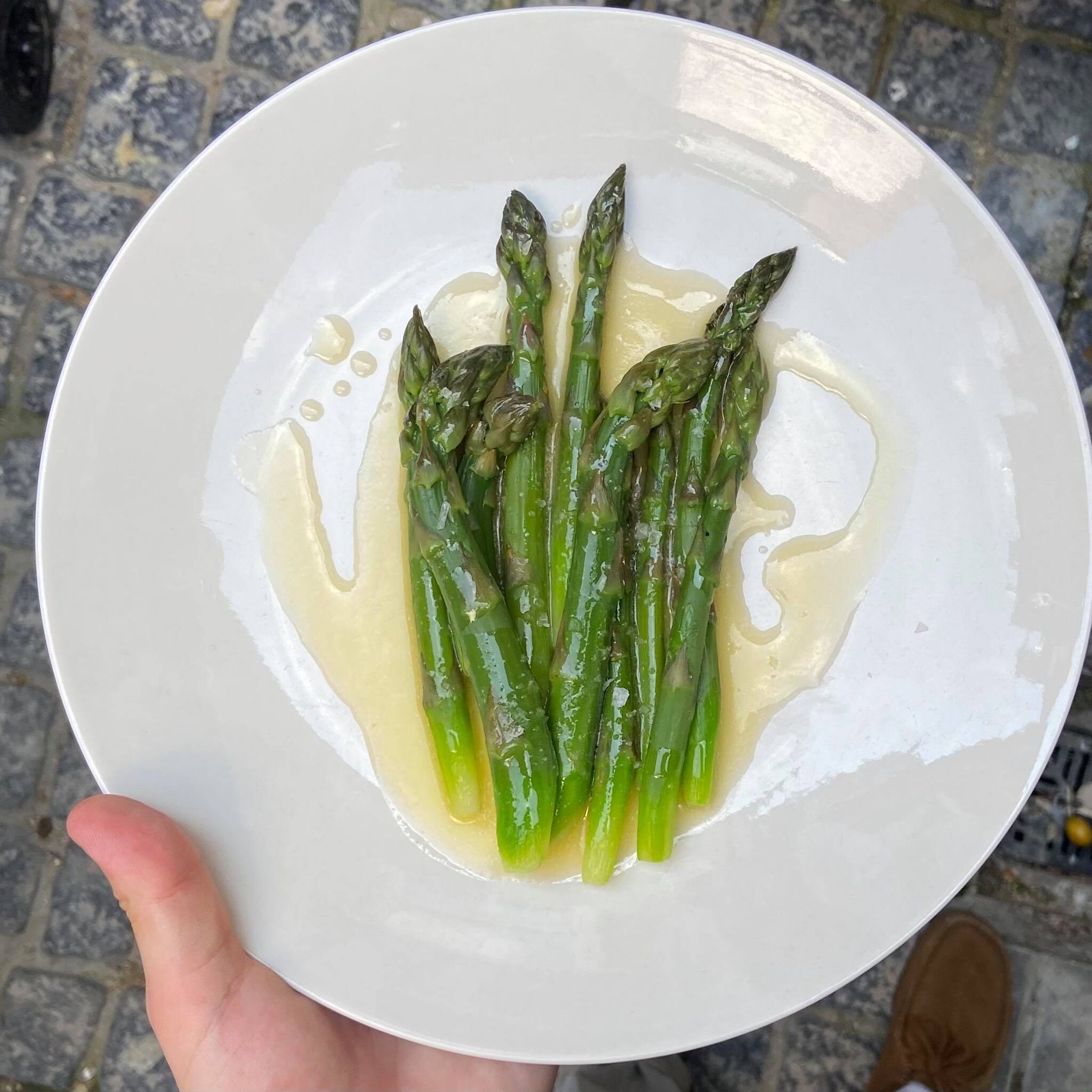Asparagus: how to appreciate, cook and enjoy the ingredient of the moment
asparagus: how to appreciate, cook and enjoy the ingredient of the moment
Henry Rousso
Illustration by Anna Morrissey
It is by all accounts a great day when you go to your local purveyor of fruits and vegetables and see that asparagus grown in the UK is available. It is a great day because it tells me that my yearly 10 month stint of not engaging with asparagus, is over. This is not because I have an aversion to foreign produce, and definitely not because asparagus grown further afield isn’t tasty, its simply because the asparagus grown on our shores is a delicate, robustly flavoursome signal of British springtime. And one worth waiting for.
I acknowledge that there is certainly a time and place for a heaping bowl of ‘weeknight Bolognese’ cooked in under an hour and laden with tinned tomatoes. There is also, however, a compelling case to be made for the slowly, lovingly prepared version, kept at a bare simmer for hours until the flavours have totally cohered and given all they can to the sauce. These are two completely different beasts, and when it comes down to it, the latter is the better beast, one worth having once a month or so when you have the time and inclination to make it properly.
This principle can be applied to a lot of what we eat; by convincing myself not to pickup a pack of asparagus from Tesco in November, I am actively increasing my own enjoyment of it come April. Seasonal eating is a bit like self-care in that way I suppose. This slow way of eating forces me to consider the ingredients in relation to their time on earth, it makes me feel connected to the world around me and the changing seasons. Knowing that in the last few months, the piece of asparagus I’m about to eat has endured the same days of sun, cold, wind and rain that I have, makes me feel more inclined to treat it with the care and respect it deserves.
Peak season Asparagus lends itself to a multitude of preparations, or rather a multitude of companions, but really it needn’t much more than some fat and salt to really shine.
Here I’ll share a simple way that I love to cook asparagus followed by some things I like to serve it with:
Blanched Asparagus
Ingredients:
1 small bunch of peak season English Asparagus (look for something robust, not the thin little wispy ones you see throughout april)
table salt
Other things:
A big pot
A big pot’s worth of water
Ice
Method:
To prepare the Asparagus grasp each spear in two hands and bend it in half. It should snap, leaving you with the tip and a further 3 quarters or so of the spear. You may toss the woody end in the bin or save it should you have some use for it in a stockpot or something. You may wish to use a vegetable peeler to neaten up the bottom inch or so of each spear by peeling down, around the outer skin. I don’t do this often, but if I were cooking for a loved one I might be inclined to.
Bring a large pot of water to boil, I’m not talking about any pot that’s big enough to fit the asparagus, I’m talking about the largest pot you have, the one that is a pain in the arse to wash up. This step is crucial if not a touch ceremonial, but it makes one feel a little like a Thomas Keller or Alain Passard. Add plenty of salt, such that the water is somewhere between generously seasoned broth and sea water. It should not be overbearingly salty. By blanching into a huge stockpot of rapidly boiling, - perfectly seasoned water - you lock all the flavour into each vibrant little spear. Conversely if you blanch directly into two inches of barely simmering water you will create the dreaded limp, dark green asparagus, and some asparagus cooking water that will taste more like asparagus than what actually ends up on the plate. The water should be back to a rapid boil within seconds of coming into contact with the asparagus, this is only achievable in a very large vessel.
Now prepare a bowl filled with ice and water.
As soon as the asparagus has seen 2 minutes of boiling water, its ready. It should be vibrantly green and just fork-tender, now quick, plunge it into the ice water! Remove the asparagus from the ice after a minute or so and pat dry.
Asparagus is arguably at its best gently warmed through in a little melted butter and topped with some flaky salt
Other things to put with/ on asparagus:
Hollandaise sauce
A little melted butter and a soft boiled egg
Gribiche or homemade tartar sauce
Grated parmesan and black pepper
Butter sauce (I make a quick one by whisking cold butter into a a few tablespoons of simmering water a little at a time till it becomes thick and glossy)
Homemade mayonnaise
Dressed crab
Strachitella and good olive oil, or any other fresh cheese for that matter.
Served cold and dipped into vinaigrette
A couple of pieces of really good smoked streaky bacon on top of the asparagus dressed in the rendered bacon fat
You get the picture, anything fat and anything salt...Anchovies... okay i’ll stop.
British Asparagus is here till the end of June. It’ll surely be a long year before next spring. I suggest making the most of the next few weeks and cooking some.



